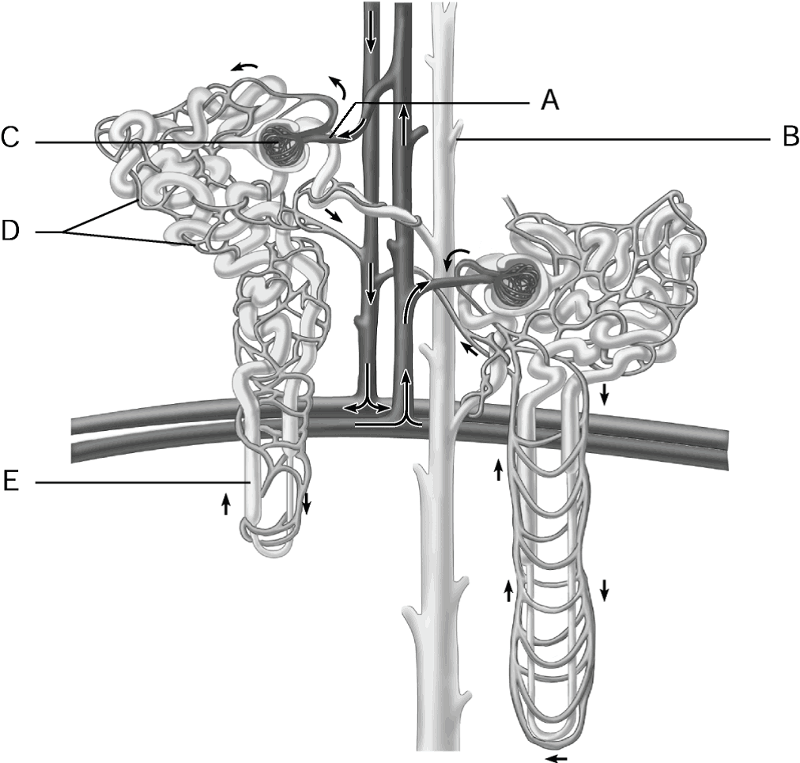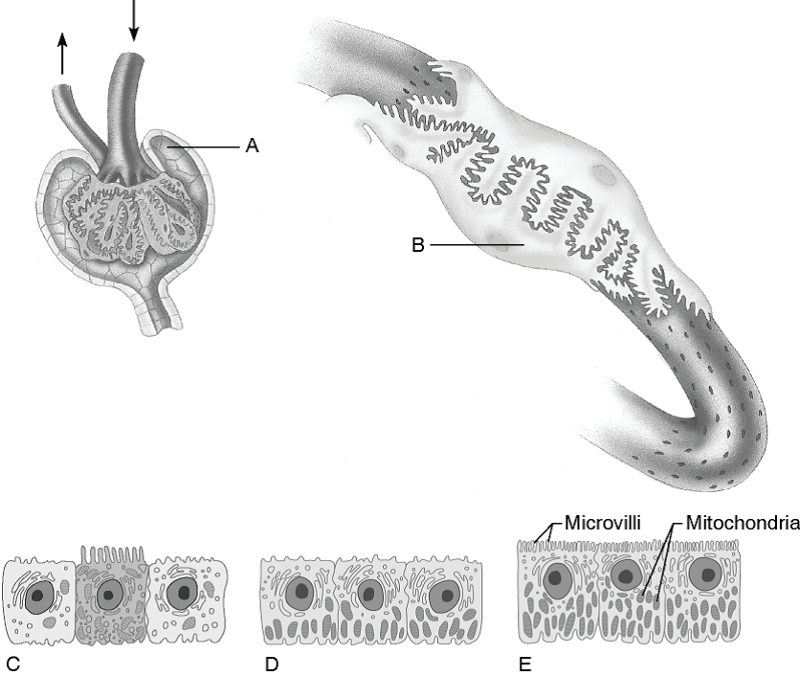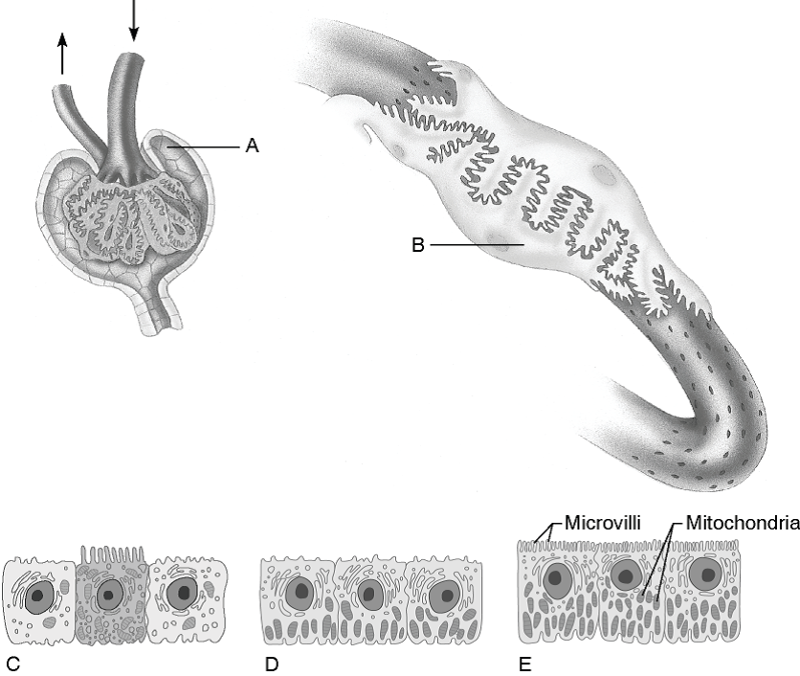
1) Glomerulus.
2) Afferent arteriole.
3) Collecting duct.
4) Loop of Henle.
5) Peritubular capillaries.
6) Structue most closely associated with granular cells.
7) Medulla of the kidney.
1) C
2) A
3) B
4) E
5) D
6) A
7) E

8) Podocyte
9) Is composed of simple squamous epithelium.
10) Collecting duct cells.
11) Proximal convoluted tubule cells.
8.B
9. A
10. C
11. E

12) Filtrate at the site of these cells is about the same osmolarity as blood plasma.
14) Cells that reabsorb virtually all the nutrients.
15) Cells that are most affected by ADH.
16) Almost no water is absorbed in these cells.
12. E
13. E
14. E
15. A
16. C
17) Proximal convoluted tubule.
A) Site that drains the distal
convoluted tubule.
B) Site
of filtrate formation.
C) Blood supply that
directly
receives substances from the
tubular cells.
D)
Receives venous blood from the
cortical radiate vein.
E)
Site at which most of the tubular
reabsorption occurs.
17) E
18) Glomerulus.
A) Site that drains the distal
convoluted tubule.
B) Site
of filtrate formation.
C) Blood supply that
directly
receives substances from the
tubular cells.
D)
Receives venous blood from the
cortical radiate vein.
E)
Site at which most of the tubular
reabsorption occurs.
18) B
19) Peritubular capillaries.
A) Site that drains the distal
convoluted tubule.
B) Site
of filtrate formation.
C) Blood supply that
directly
receives substances from the
tubular cells.
D)
Receives venous blood from the
cortical radiate vein.
E)
Site at which most of the tubular
reabsorption occurs.
19) C
20) Collecting duct.
A) Site that drains the distal
convoluted tubule.
B) Site
of filtrate formation.
C) Blood supply that
directly
receives substances from the
tubular cells.
D)
Receives venous blood from the
cortical radiate vein.
E)
Site at which most of the tubular
reabsorption occurs.
20) A
21) Arcuate vein.
A) Site that drains the
distal
convoluted tubule.
B) Site of filtrate
formation.
C) Blood supply that directly
receives substances
from the
tubular cells.
D) Receives venous blood from
the
cortical radiate vein.
E) Site at which most of the
tubular
reabsorption occurs.
21) D
1) The mechanism that establishes the medullary osmotic gradient
depends most on the
permeability properties of the ________.
A) loop of Henle
2) Urine passes through the ________.
B) pelvis of the kidney to ureter to bladder to urethra
3) Which of the following is associated with the renal
corpuscle?
A) a podocyte
B) a vasa recta
C) a fenestrated capillary
D) an efferent arteriole
B) a vasa recta
4) An increase in the permeability of the cells of the collecting tubule to water is due to ________.
B) an increase in the production of ADH
5) The urinary bladder is composed of ________ epithelium.
A) transitional
6) The kidneys are stimulated to produce renin ________.
C) by a decrease in the blood pressure
7) Blood vessels of the renal columns are called ________.
C) interlobar
8) Which gland sits atop each kidney?
A) adrenal
9) The ________ artery lies on the boundary between the cortex and medulla of the kidney.
B) arcuate
10) The glomerulus differs from other capillaries in the body in that it ________.
C) is drained by an efferent arteriole
11) The descending limb of the loop of Henle ________.
D) contains fluid that becomes more concentrated as it moves down into the medulla
12) Select the correct statement about the ureters.
A) Ureters contain sphincters at the entrance to the bladder to
prevent the backflow of urine.
B) The epithelium is stratified
squamous like the skin, which allows a great deal of stretch.
C)
The ureters are capable of peristalsis like that of the
gastrointestinal tract.
D) The ureter is innervated by
parasympathetic nerve endings only.
C) The ureters are capable of peristalsis like that of the gastrointestinal tract.
13) The fatty tissue surrounding the kidneys is important because ________.
B) it stabilizes the position of the kidneys by holding them in their normal position
B) it stabilizes the position of the kidneys by holding them in their normal position
14) The renal corpuscle is made up of ________.
A) Bowmans capsule and glomerulus
A) Bowmans capsule and glomerulus
15) The functional and structural unit of the kidneys is ________.
A) the nephron
A) the nephron
The juxtaglomerular apparatus is responsible
D) regulating the rate of filtrate formation and controlling systemic blood pressure
The fatty tissue surrounding the kidneys is important because ________.
it stabilizes the position of the kidneys by holding them in their normal position
The functional and structural unit of the kidneys is ________.
A) the nephron
17) The chief force pushing water and solutes out of the blood across
the filtration membrane is
________.
C) glomerular hydrostatic pressure (glomerular blood pressure)
18) Which of the following statements describes the histology of the
ureters?
A) They are trilayered (mucosa, muscularis, and
adventitia).
B) They are actually an extension of the visceral
peritoneum.
C) They are made up of several layers of
endothelium.
D) They are made up entirely of muscle tissue
because they need to contract in order to
transport urine efficiently.
A) They are trilayered (mucosa, muscularis, and adventitia)
19) The first major branch of the renal artery is ________.
A)
arcuate B) interlobular
C) segmental D) cortical radiate
segmental
20) Which of the following acts as the trigger for the initiation of
micturition (voiding)?
A) The stretching of the bladder wall
serves as the trigger.
B) Motor neurons control
micturition.
C)The pressure of the fluid in the bladder opens a
sphincter and allows the urine to flow by
gravity down the
urethra.
D) The sympathetic efferents are the predominant system
controlling micturition.
A) The stretching of the bladder wall serves as the trigger
21) The filtration membrane includes all except ________.
A)
glomerular endothelium B) podocytes
C) renal fascia D) basement membrane
C) renal fascia
22) The mechanism of water reabsorption by the renal tubules is
________.
A) active transport B) osmosis
C) solvent drag D)
cotransport with sodium ions
B) osmosis
23) Most electrolyte reabsorption by the renal tubules
________.
A) is not Tm limited
B) is in the distal
convoluted tubule
C) is hormonally controlled in distal tubule
segments
D) is completed by the time the loop of Henle is reached
C) is hormonally controlled in distal tubule segments
24) The macula densa cells respond to ________.
A) aldosterone
B) antidiuretic hormone
C) changes in pressure in the tubule D)
changes in solute content of the filtrate
D) changes in solute content of the filtrate
25) Which of the following is not reabsorbed by the proximal
convoluted tubule?
A) Na+ B) K+ C) glucose D) creatinine
D) creatinine
26) The fluid in the glomerular (Bowman's) capsule is similar to
plasma except that it does not
contain a significant amount of
________.
A) glucose B) hormones
C) electrolytes D) plasma protein
D) plasma protein
27) Alcohol acts as a diuretic because it ________.
A) is not
reabsorbed by the tubule cells
B) increases the rate of
glomerular filtration
C) increases secretion of ADH
D)
inhibits the release of ADH
D) inhibits the release of ADH
28) The function of angiotensin II is to ________.
A)constrict
arterioles and increase blood pressure
B) decrease the production
of aldosterone
C) decrease arterial blood pressure
D)
decrease water absorption
A)constrict arterioles and increase blood pressure
29) A disease caused by inadequate secretion of antidiuretic hormone
(ADH) by the pituitary
gland with symptoms of polyuria is
________.
A) diabetes mellitus B) diabetes insipidus
C)
diabetic acidosis D) coma
B) diabetes insipidus
An important characteristic of urine is its specific gravity or
density, which is ________.
A) 1.041-1.073 B) 1.001-1.035 C)
1.030-1.040 D) 1.000-1.015
B) 1.001-1.035
31) Place the following in correct sequence from the formation of a
drop of urine to its elimination
from the body.
1. major
calyx
2. minor calyx
3. nephron
4. urethra
5.
ureter
6. collecting duct
A) 3, 1, 2, 6, 5, 4 B) 6, 3, 2, 1,
5, 4 C) 2, 1, 3, 6, 5, 4 D) 3, 6, 2, 1, 5, 4
D) 3, 6, 2, 1, 5, 4
3. nephron, 6. collecting duct, 2. minor calyx,
1. major calyx, 5. ureter, 4. urethra
32) Select the correct statement about the nephrons.
A) The
parietal layer of the glomerular capsule is simple squamous
epithelium.
B) The glomerulus is correctly described as the
proximal end of the proximal convoluted
tubule.
C) Podocytes
are the branching epithelial cells that line the tubules of the
nephron.
D) Filtration slits are the pores that give fenestrated
capillaries their name.
A) The parietal layer of the glomerular capsule is simple squamous epithelium.
34) Which of the following is not a part of the juxtaglomerular
apparatus?
A) granular cells B) macula densa
C) podocyte
cells D) mesangial cells
C) podocyte cells
35) Tubular reabsorption ________.
A) includes substances such
as creatinine
B) by active mechanisms usually involves movement
against an electrical and/or chemical
gradient
C) by passive
processes requires ATP to move solutes from the interior of the tubule
to the
blood
D) is a way for the body to get rid of unwanted waste
B) by active mechanisms usually involves movement against an
electrical and/or chemical
gradient
36) Which statement is true about urine?
A) Urine is usually
slightly alkaline.
B) Urine has an ammonialike odor when
fresh.
C) Urine has nitrogenous waste such as urea and uric
acid.
D) Urine has a yellow color due to the presence of hemoglobin
C) Urine has nitrogenous waste such as urea and uric acid
37) Reabsorption of high levels of glucose and amino acids in the
filtrate is accomplished by
________.
A) facilitated
diffusion B) passive transport
C) countertransport D) secondary
active transport
D) secondary active transport
38) While the kidneys process about 180 L of blood-derived fluids
daily, the amount that actually
leaves the body is
________.
A) 50%, or 90 L B) all of the 180 L C) 1%, or 1.8 L D)
100 L
C) 1%, or 1.8 L
39) Fetal kidneys do not have to work very hard because
________.
A) fetuses do not have any waste to excrete
B)
there are no functional nephrons until after birth
C) the
placenta allows the mother's urinary system to clear the waste from
fetal blood
D) there is no way a fetus could excrete urine until
the seventh month of development
C) the placenta allows the mother's urinary system to clear the waste from fetal blood
40) Which of the following best describes kidney function in older adults (70 years or older)?
A) Kidney function remains the same throughout life, regardless of
age.
B) Only about 3% of older adults have any loss of kidney
function.
C) Only obese and diabetic older adults have any kidney
dysfunction.
D) Kidney function decreases due to kidney atrophy.
D) Kidney function decreases due to kidney atrophy.
41) The factor favoring filtrate formation at the glomerulus is
________.
A) the colloid osmotic pressure of the blood
B)
the glomerular hydrostatic pressure
C) the capsular hydrostatic
pressure
D) the myogenic mechanism
B) the glomerular hydrostatic pressure
42) If the Tm for a particular amino acid is 120 mg/100 ml and the
concentration of that amino acid
in the blood is 230 mg/100 ml,
the amino acid ________.
A) will be actively secreted into the
filtrate
B) will be completely reabsorbed by the tubule
cells
C) will appear in the urine
D) will be reabsorbed by
secondary active transport
C) will appear in the urine
43) If one says that the clearance value of glucose is zero, what
does this mean?
A) The glucose molecule is too large to be
filtered out of the blood.
B) Most of the glucose is filtered out
of the blood and is not reabsorbed in the
convoluted
tubules.
C) Normally all the glucose is
reabsorbed.
D) The clearance value of glucose is relatively high
in a healthy adult.
C) Normally all the glucose is reabsorbed.
44) Excretion of dilute urine requires ________.
A) relative
permeability of the distal tubule to water
B) impermeability of
the collecting tubule to water
C) transport of sodium and
chloride ions out of the descending loop of Henle
D) the presence
of ADH
B) impermeability of the collecting tubule to water
45) As the renal artery approaches the kidney, it branches to supply
the renal tissue. Place the
following in correct sequence
starting from the renal artery.
1. segmental
2. cortical
radiate
3. arcuate
4. interlobar
A) 1, 4, 3, 2
1. segmental
4. interlobar
3. arcuate
2. cortical radiate
46) In the ascending limb of the loop of Henle ________.
A) the
thin segment is freely permeable to water
B) the thick segment is
permeable to water
C) the thin segment is not permeable to sodium
and chloride
D) the thick segment moves ions out into
interstitial spaces for reabsorption
D) the thick segment moves ions out into interstitial spaces for reabsorption
47) Select the correct statement about urinary system
development.
A) Kidneys develop from urogenital ridges.
B)
The metanephric ducts will become the urethras.
C) The pronephros
(first tubule system) develops during the tenth week of
gestation.
D) The mesonephros will develop into the kidneys.
A) Kidneys develop from urogenital ridges.
48) The disruption in homeostasis known as pyelitis is
________.
A) a virus that appears only in children because of
poor hygiene
B) the aftermath of a severe upper respiratory
infection
C) an infection of the renal pelvis and calyces
D)
more prevalent in the elderly
C) an infection of the renal pelvis and calyces
49) Which statement is correct?
A) Reabsorption of water is
hormonally controlled.
B) Normal filtrate contains a large amount
of protein.
C) Most of the water passing through the kidney is
eliminated as urine.
D) The excretion of sodium ions is one of
the mechanisms that maintains the pH balance of
the blood.
A) Reabsorption of water is hormonally controlled.